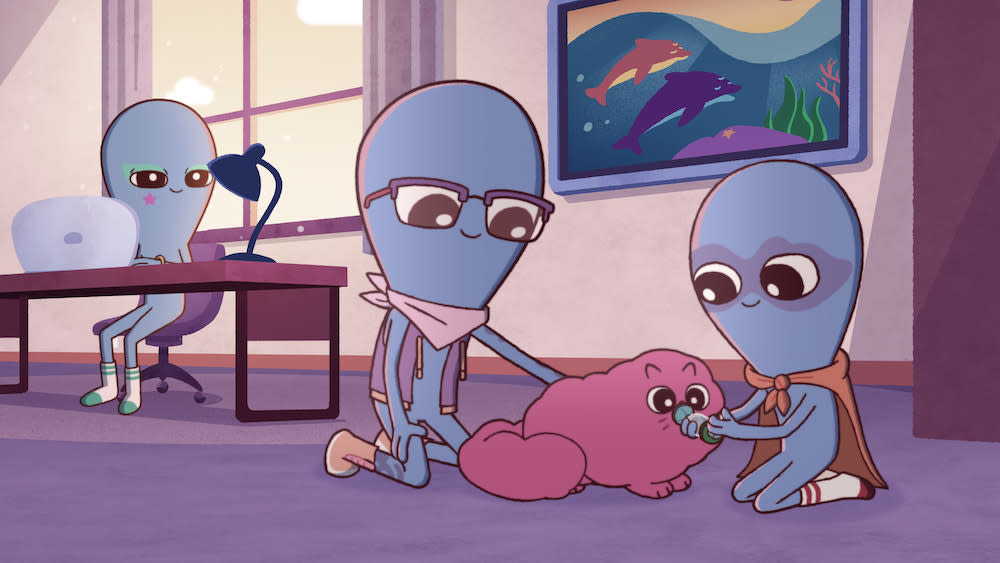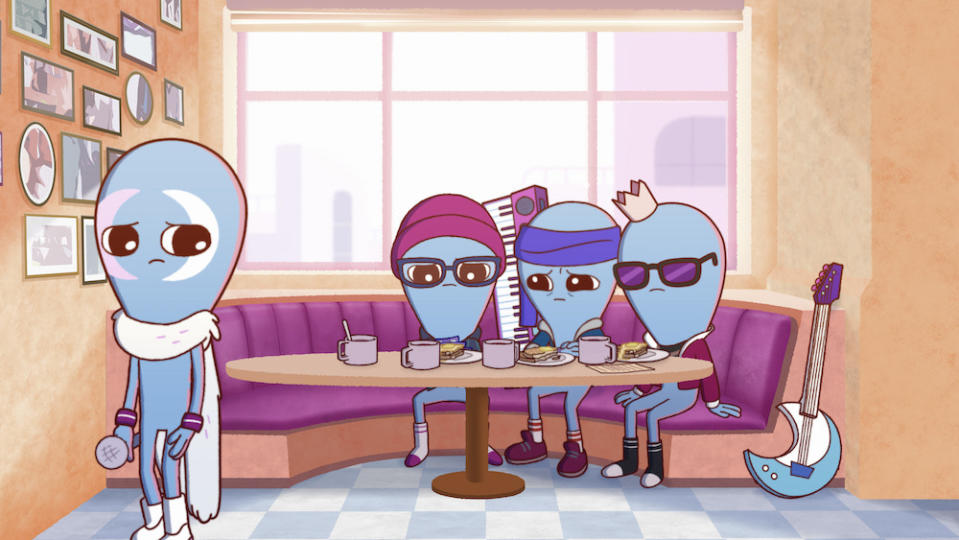‘Strange Planet’ Isn’t Nearly Strange Enough

“Strange Planet” is a simple show, and purposefully so. Based on the popular comic strips by Nathan W. Pyle, who co-created the Apple TV+ series with “Rick & Morty’s” Dan Harmon, the half-hour animated episodes chronicle common human experiences through an alien lens of heightened objectivity. Characters aren’t human beings, they’re just “beings” (blue, hairless not-people — who still get called people sometimes — with giant round heads). Their world isn’t Earth, but it follows the same general rules. There may be machines that can generate an infinite supply of pancakes and good social etiquette doesn’t seem to require wearing pants, but there are still cats and dogs, planes and buses, parents and children.
The twist (if you can call it that) is that on this strange planet, cats are called “tiny vibrating creatures.” Planes are “flying machines,” buses are “group roll machines,” and parents are “lifegivers.” Many common objects and activities are given new names, which helps to illustrate just how peculiar so many of the things we take for granted can be, once you take a minute to consider the weird wonders that fill our daily lives.
More from IndieWire
'What We Do in the Shadows' Episode 6 Stresses the Urgency of Guillermo's Situation - Spoilers
'Wednesday' Brought a Tim Burton Twist to the Addams Family Aesthetic
Only, that’s about as long as it takes: One minute is all you need to think about why we’re drawn to certain “creatures” (aka pets) over others, or why we often experience an existential crisis on our birthdays (aka “emergence day”). After all, TV shows with real human characters have posed the very same questions many, many times, for many, many years. Implementing typical sitcom arcs in an atypical setting while leaning on a quirky vernacular isn’t enough to make us forget we’re watching yet another episode about why sports fandom can seem silly. What’s cute and creative in a four-panel comic strip becomes cheesy and conventional over 25 minutes, if not mind-numbingly repetitive across 10 episodes. “Strange Planet” does far too little to make its own world enticing, instead choosing to persistently point out how odd everything is on Earth.

But hey, at least it’s a nice show. Told in a largely episodic format with only a few ongoing plots, “Strange Planet” begins with brief narrated summary of the chosen topic. Maybe this episode is about leaving for college, or performing on stage, or, like in the pilot, the act of flying. The latter works well enough as a series introduction, given how familiar hurtling hundreds of miles per hour through the sky has become, as well as the abundance of emotions tied to each trip. Quick little vocabulary jokes are equally plentiful. (Flight attendants are “comfort coordinators,” tray tables are “pretend tables,” alcohol is “mild poison,” etc.) Story beats work in similar fashion to Pyle’s comic strips. (Our protagonist is a comfort coordinator who has just the right answer for one surly flyer’s every complaint: Hungry? “Tiny snacks.” Cold? Have a blanket. “The star (aka the sun) is in my eyes.” Well, have some complimentary sunglasses.)
And yet… even before we reach the minor character arcs stitching together these kooky vignettes, “Strange Planet” feels like it’s taking too much for granted. There’s no new names given for “blanket” or “sunglasses.” The flight itself merely introduces our B-plot characters (who are on their way to a concert), rather than elicit a flying-centric emotion from them to extend the thematic starting point. Plus, the demanding passenger may be fussy, but he’s still polite by today’s social media-set standards — and that’s what matters. “Strange Planet” tracks nice people interacting with other nice people as they deal with big and small hiccups in their lives. Falling back on pleasant feelings can be charming, but here, it too often masks a lack of jokes, effort, or deeper meaning.
Maybe viewers can plod along for a few episodes, coasting on the good vibes, but eventually you need to feel something other than innocuous neutrality. The stakes of each story tend to be rooted in low-level cartoon hijinks, which might be more understandable in a kids’ show, but “Strange Planet” is being billed as Apple’s “first adult animated series.” (Apparently “Central Park,” which is built around an ongoing real estate deal, doesn’t count.) Even if “Strange Planet’s” issues are meant to address adult concerns, solutions skew simplistic. If your siblings and parents don’t like what you like, just keep trying to find common ground. If your coworkers struggle to see you as a boss and a friend, don’t worry, they’ll come around. And if you’re an insecure teenager struggling to make friends, other friends will come along and old friends will circle back! No problem!
Listen, sometimes these things are not only nice to hear, they’re necessary. But the best sitcoms find specific paths for their characters to reach these universal revelations. “Strange Planet” far too often paints with a broad brush (and that includes the animation style — an endearing, tranquil color palette filling in broad, homogeneous designs that lack visual wit and never quite spring to life). In the long run, simple kindness only goes so far. And on TV, you can’t be afraid to get really, truly weird.
Grade: C
“Strange Planet” premieres Wednesday, August 9 on Apple TV+ with three episodes. New episodes will be released weekly.
Best of IndieWire
Sign up for Indiewire's Newsletter. For the latest news, follow us on Facebook, Twitter, and Instagram.

